Sponsor
Promotions
Popular With
Radio Listeners
Part II
“Sit
right down after tonight’s adventure
and print your name and address plainly on a piece of paper.
Send it in along with the thin metal foil seal
from under the lid of a can of sweet chocolate flavored Ovaltine.”
--Pierre André
Lincoln, Me. (DG)—
Part I of this series focused on
contests that were heard on radio. There
was no doubt the radio listeners enjoyed participating in the different contests
heard on the air. Contests were
fun, but there was a noticeable disadvantage.
Out of the millions of people who sent in entries, only a few actually
won a prize. Unfortunately, that
meant the vast majority of those millions of people didn’t win anything at
all. Luckily, the sponsor had
another promotion where everyone were guaranteed to receive something---
provided they sent in the correct amount of change and a part of the product’s
anatomy. This was the premium
offer.
Like the contests, premium offers
were also a test of the popularity of the product and the program that product
sponsored. Money wise, premiums
couldn’t compare with the thousands of dollars in prizes contests provided---
but they were just as popular with the radio listeners.
Although major sponsors like Procter
& Gamble, Lever Brothers, General Foods, Colgate-Palmolive-Peet, Sterling
Drug, General Mills, and American Home Products
participated in premium offers, this article will focus on the other sponsors
who also had their share of premium offers on the radio.
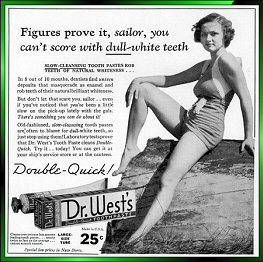 The
earliest premium I have come across was also one of the most unusual.
It was heard on a 1933 broadcast of THE ADVENTURES OF FRANK
MERRIWELL serial program over NBC’s Red Network.
During the commercial, announcer Harlow Wilcox informed the young
listeners of a chance to own a “Racing Turtle.” The
earliest premium I have come across was also one of the most unusual.
It was heard on a 1933 broadcast of THE ADVENTURES OF FRANK
MERRIWELL serial program over NBC’s Red Network.
During the commercial, announcer Harlow Wilcox informed the young
listeners of a chance to own a “Racing Turtle.” The turtle Wilcox described was not a toy, but a real live turtle.
It was 1½” long, and it was easy for the children to take care of.
With each turtle, instructions were included on how to take care of it.
Unlike other premiums, there was no money needed.
All was required was to send in 2 Dr. West’s Tooth
Paste cartons to a special address, care of the local radio station
where the broadcast was heard.
The turtle Wilcox described was not a toy, but a real live turtle.
It was 1½” long, and it was easy for the children to take care of.
With each turtle, instructions were included on how to take care of it.
Unlike other premiums, there was no money needed.
All was required was to send in 2 Dr. West’s Tooth
Paste cartons to a special address, care of the local radio station
where the broadcast was heard.
Many
premium offers heard on the air were involved in the program’s story.
A good example took place in 1935 on LUM & ABNER.
With the “Jot ‘em Down Store” temporarily out of
business, Lum Edwards acquired the rights to sell a handy aluminum pocket
flashlight. The idea was to sell
enough flashlights in order for Lum and his partner Abner Peabody to restock and
eventually reopen the store. Lum
told Abner that he wrote a letter to the Horlick’s Malted
Milk Company (the program’s sponsor) about the flashlights.
He was hoping the company would be interested in sponsoring them.  In a reply, Mr. Horlick stated that he was impressed with the flashlight,
and the company will sponsor them as a premium offer.
Once Lum finished reading Mr. Horlick’s reply, the premium was
official.
In a reply, Mr. Horlick stated that he was impressed with the flashlight,
and the company will sponsor them as a premium offer.
Once Lum finished reading Mr. Horlick’s reply, the premium was
official.  Announcer Carlton
Brickert informed the listeners that they could receive the same handy aluminum
pocket flashlight for only 10¢ and a wrapper from a jar of Horlick’s
Malted Milk. Brickert also
stated that it was ONLY from Horlick’s
Malted Milk. The wrappers
from Horlick’s Malted Milk Tablets were not eligible. Announcer Carlton
Brickert informed the listeners that they could receive the same handy aluminum
pocket flashlight for only 10¢ and a wrapper from a jar of Horlick’s
Malted Milk. Brickert also
stated that it was ONLY from Horlick’s
Malted Milk. The wrappers
from Horlick’s Malted Milk Tablets were not eligible.
As
the story and the premium offer progressed, Lum and Abner received enough money
from the premium sales to restock the store.
This was good news for Lum & Abner, but a difference of opinion
developed between the 2 men as to who would be the president of the “New”
Jot ‘Em Down Store when it officially reopened.
It was a difference of opinion where the listeners could participate.
With
the flashlight premium still in full force, Brickert asked the listeners who
were about to send for the flashlight to vote for the store’s president.
The listeners voted by writing either “Lum” or “Abner” on the Horlick’s
wrapper they were sending in. There
was no compensation by voting, except it gave the listeners a chance to
participate in how the story turned out. When
the election ended, Dick Huddleston, Grandpappy Spears, and Squire Skimp counted
the votes in the back room of the Jot ‘Em Down Store. With the counting going on, Lum and Abner were anxiously
awaiting for the results. When all
the votes were finally counted, Lum won the election by a narrow margin.
He would then turn over his newly elected office over to Abner.
The
response to Horlick’s Flashlight Premium was overwhelming.
So much so, Brickert informed the listeners that demand was exceeding
supply. He asked the listeners to
be patient. The flashlights were
being made and sent out as fast as humanly possible.
2
popular brands of cleanser, Bab-O and Old Dutch to
be exact, both had a lot of premium offers during their years as radio sponsors.
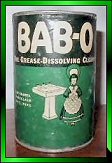 B.T.
Babbitt’s bouncing baby cleanser, Bab-O
(it’s easier to write it than say it), sponsored premiums that not
only were involved with the programs it sponsored; they also brought out the
talents of the lead characters of those programs. B.T.
Babbitt’s bouncing baby cleanser, Bab-O
(it’s easier to write it than say it), sponsored premiums that not
only were involved with the programs it sponsored; they also brought out the
talents of the lead characters of those programs.
On
the DAVID HARUM serial program, hero David Harum was in trouble
with the law. This trouble was
serious enough that if convicted, he may have to serve a jail sentence.
Confusing to his friends and the radio listeners, David didn’t appear
to be particularly interested in clearing himself of the crime.
Instead, he was focusing his attention on learning how to use a camera.
By sheer coincidence, announcer Ford Bond offered a candid style camera
to the radio listeners. This camera wasn’t a toy, but a real Uniflex Candid
Style camera that took quality pictures.
Bond informed the listeners that all it took to receive this camera was
to send it 25¢ and a dark green band from a Bab-O can.
Although I don’t know how David overcame the trouble he was in, more
than likely it was his ability to take pictures that helped him and the law
catch the guilty party.
On
the LORA LAWTON serial program, the radio listeners found out for
themselves how talented heroine Lora Lawton really was.
On the program, Lora designed some Christmas cards to send to her friends
and family. Since she was an all
round good egg, Lora graciously offered her creations to the radio listeners.
Announcer Ford Bond mentioned the premium contained 10 different cards.
They were French fold cards, decorated in all the Christmas colors.
In order to obtain this premium, Bond offered the listeners 2 different
options. For 10 cards, the
listeners sent in 25¢ and the green band from a Bab-O can. If the listeners wanted 50 cards, the listeners sent in $1
and the green band from a Bab-O can.
As
far as I know, Old Dutch Cleanser’s premiums on the radio
didn’t involve the programs it sponsored.
The premiums I have come across consisted of either costume jewelry or
handy household items.
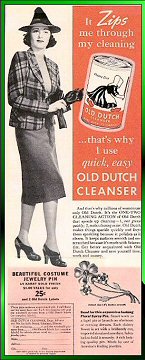 On
a 1939 broadcast of BACHELOR’S CHILDREN, announcer Russ Young
described the latest Old Dutch Cleanser premium. On
a 1939 broadcast of BACHELOR’S CHILDREN, announcer Russ Young
described the latest Old Dutch Cleanser premium.  It was a piece of costume jewelry known as a “Floral Spray Pin.”
Young stated it was a 14-karat gold pin that was specially made for Old
Dutch by one of America’s leading jewelers. The pin was 2 ½” long and featured 3 flowers, 1 large and
2 small, with long stems intertwined together.
The Floral Spray Pin was ideal as a lapel pin or brooch to be worn with
afternoon or evening dresses. In
order for the listeners to obtain this premium, the listeners had to send in 25¢
and the windmill pictures from the back of 2 Old Dutch Cleanser
cans.
It was a piece of costume jewelry known as a “Floral Spray Pin.”
Young stated it was a 14-karat gold pin that was specially made for Old
Dutch by one of America’s leading jewelers. The pin was 2 ½” long and featured 3 flowers, 1 large and
2 small, with long stems intertwined together.
The Floral Spray Pin was ideal as a lapel pin or brooch to be worn with
afternoon or evening dresses. In
order for the listeners to obtain this premium, the listeners had to send in 25¢
and the windmill pictures from the back of 2 Old Dutch Cleanser
cans.
Even
before the premiums were presented on the air, the listeners automatically knew
in order to obtain the premiums from these 2 products, the dark green band on
the Bab-O Cleanser can, or the windmill pictures from the back of
2 Old Dutch Cleaner cans were
sent
in--- along with a small amount of change.
 For
those people who really wanted the premiums A.S.A.P., this might be interesting.
Cleaning the kitchen sink was adventurous with Old Dutch---
with a hole at the bottom of the can where the windmill picture used to be.
If you think that’s bad, imagine pouring cleanser from a Bab-O
can with the dark green band missing from the top of the can.
Instead of pouring a small amount of cleanser, Bab-O’s
newly ventilated can poured out ALL the cleanser! For
those people who really wanted the premiums A.S.A.P., this might be interesting.
Cleaning the kitchen sink was adventurous with Old Dutch---
with a hole at the bottom of the can where the windmill picture used to be.
If you think that’s bad, imagine pouring cleanser from a Bab-O
can with the dark green band missing from the top of the can.
Instead of pouring a small amount of cleanser, Bab-O’s
newly ventilated can poured out ALL the cleanser!
Premiums
weren’t just for the adult radio listeners.
Although there were many premium offers for adults, the majority of
premiums on the radio were heard on the juvenile serial programs, under the
sponsorship of breakfast cereals, candy, and malted milk products.
Just like the premium offers for adults, all was required was a small
amount of change and part of the product’s packaging.
The
majority of these premiums involved the program the product sponsored.
Unlike the premiums for adults, the announcers on the juvenile serial
programs displayed a very persuasive tone in their voice.
They made the premium they were selling very hard to pass up by the young
listeners.
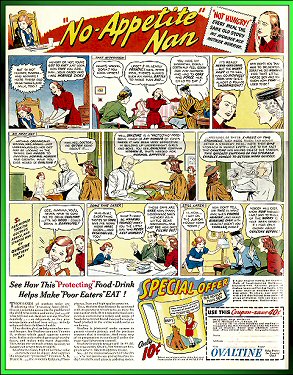 For
the young listeners who listened to LITTLE ORPHAN ANNIE, they
found out Ovaltine, the program’s sponsor, tasted a little bit
better when it was drunk out of a Little Orphan Annie Shake Up Mug.
It was an unbreakable dark green mug with the picture of Little Orphan
Annie and her dog Sandy (ARF!)
on the front. The mug
also included a bright red top. The
object here was to create an “Ovaltine Shake Up.”
Ovaltine and milk were poured into the mug; the red cap was
applied to the top; and some vigorous shaking took place.
When the constant shaking was starting to wear out the young listeners,
the red cap was removed, and they enjoyed their Ovaltine Shake Up.
It was a milk shake in the truest sense of the words. For
the young listeners who listened to LITTLE ORPHAN ANNIE, they
found out Ovaltine, the program’s sponsor, tasted a little bit
better when it was drunk out of a Little Orphan Annie Shake Up Mug.
It was an unbreakable dark green mug with the picture of Little Orphan
Annie and her dog Sandy (ARF!)
on the front. The mug
also included a bright red top. The
object here was to create an “Ovaltine Shake Up.”
Ovaltine and milk were poured into the mug; the red cap was
applied to the top; and some vigorous shaking took place.
When the constant shaking was starting to wear out the young listeners,
the red cap was removed, and they enjoyed their Ovaltine Shake Up.
It was a milk shake in the truest sense of the words.
Whether
or not Ovaltine really tasted better in a Little Orphan Annie
Shakeup Mug depended on the individual’s opinion.
Announcer Pierre André made a convincing point on the commercial that it
did taste better in the mug. André’s
sales pitch was so convincing, the young listeners just had to have the Little
Orphan Annie Shake Up Mug. Although
other premium offers for the Little Orphan Annie Shake Up Mug ranged from 10¢-50¢
(depending on what year the premium was offered), it was offered absolutely free
for this 1940 promotion. Of course,
the metal foil seal from an Ovaltine container still had to be
sent in.
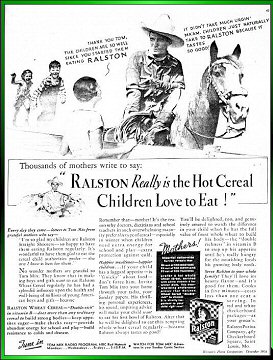 Ralston,
Instant Ralston, and Shredded Ralston
had a hand in numerous radio premiums featuring the legendary cowboy Tom Mix.
Like Pierre André did in selling the premiums for Ovaltine,
announcer Don Gordon also used a very persuasive sales pitch to convince the
young listeners they had to have that particular premium. Ralston,
Instant Ralston, and Shredded Ralston
had a hand in numerous radio premiums featuring the legendary cowboy Tom Mix.
Like Pierre André did in selling the premiums for Ovaltine,
announcer Don Gordon also used a very persuasive sales pitch to convince the
young listeners they had to have that particular premium.  It didn’t take much convincing, because it was exciting for a young
listener to own something with Tom Mix’s name or picture on it.
The same holds true for the other heroes and heroines on the juvenile
serial programs.
It didn’t take much convincing, because it was exciting for a young
listener to own something with Tom Mix’s name or picture on it.
The same holds true for the other heroes and heroines on the juvenile
serial programs.
How popular were premium offers on
the radio? Herbert Brean’s
article The Box Top Business in the March 14, 1949 issue of Life
Magazine indicated they were very popular. The article estimated about
120,000 requests for premiums were received in a day’s time.
With that many entries, extra post office boxes were rented and extra
people were hired to handle the avalanche of mail--- talk about job security!
Premiums during radio’s golden age
were a profitable and never ending business for the people in charge of creating
the items and the companies who sponsored them.
If any of the premiums were kept to this very day, they are now
collector’s items. Maybe the
children of today wouldn’t appreciate a Tom Mix pocketknife or a Jack
Armstrong Pedometer, but for the people who either owned these premiums or
listened to the programs offering them, they had a special meaning.
|